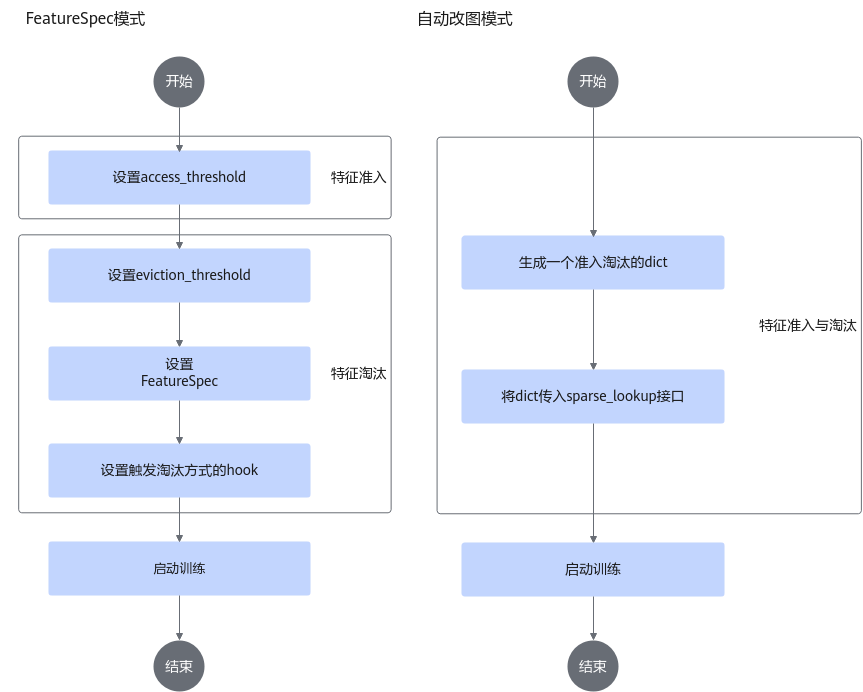当某些特征的频率过低时,对模型的训练效果不会有帮助,还会造成内存浪费以及过拟合的问题。因此需要特征准入功能来过滤掉频率过低的特征。
对于一些对训练没有帮助的特征,需要将其淘汰以免影响训练效果,同时节约内存。Rec SDK支持特征淘汰功能,并提供了两种特征淘汰的触发方式,一是根据global step触发淘汰,二是根据时间间隔触发淘汰。

开启淘汰功能后,不支持片上内存显存侧动态扩容。
使用流程介绍
本节介绍如何使用特征准入与淘汰进行训练,涉及FeatureSpec模式与自动改图模式。
图1 特征准入与淘汰使用流程


关键步骤介绍
- 在FeatureSpec模式下,请参考FeatureSpec进行配置。
- 开启准入功能需要设置准入阈值“access_threshold”大于或等于0(单位:次),设置阈值小于“-1”时将会报参数错误。
- 开启淘汰功能需要依次执行以下步骤:
- 设置淘汰阈值“eviction_threshold”大于或等于0(单位:秒),设置阈值小于“-1”时将会报参数错误。
- 设置“index_key”索引键为“timestamp”的FeatureSpec并携带参数is_timestamp=True,代表数据集含有时间戳。
- 使用EvictHook接口为淘汰的触发方式设置“hook”,接口参数有三个,evict_enable=True,evict_time_interval=24 * 60 * 60,evict_step_interval=10000,分别代表淘汰功能开关、淘汰触发的时间间隔(单位:秒)、global step间隔。“evict_time_interval”与“evict_step_interval”参数可选其一。
- 特征淘汰功能hook仅在训练模式下使用。
- 在自动改图模式下,请参考自动改图进行配置。
仅需要在使用sparse_lookup接口时,设置“access_and_evict_config”参数,参数类型dict,该dict由两个key-value对组成,key分别为“access_threshold”和“eviction_threshold”,value为对应的阈值。
- 环境变量“USE_COMBINE_FAAE”控制是否合表统计次数。如果USE_COMBINE_FAAE=0,表示分表统计,每张表key的count记录是独立的;如果USE_COMBINE_FAAE=1,表示合表统计,多张表维护一个count记录。
- 提供一个cpu算子set_threshold支持在训练过程中更改准入阈值。

如果set_threshold的第一个入参值为“0”,表示修改对应的emb表为特征不累加模式(准入阈值不变,但是特征计数不再累加,使用历史值)。
示例代码
- FeatureSpec模式。
1 2 3 4 5 6 7 8 9
feature_spec_list = [FeatureSpec("user_ids", feat_count=cfg.user_feat_cnt, table_name="user_table", access_threshold=access_threshold, eviction_threshold=eviction_threshold, faae_coefficient=1), FeatureSpec("item_ids", feat_count=cfg.item_feat_cnt, table_name="item_table", access_threshold=access_threshold, eviction_threshold=eviction_threshold, faae_coefficient=4), FeatureSpec("timestamp", is_timestamp=True)]
hook_evict = EvictHook(evict_enable=True, evict_time_interval=24*60*60, evict_step_interval=10000)
- 自动改图模式。
config_for_user_table = dict(access_threshold=cfg.access_threshold, eviction_threshold=cfg.eviction_threshold, faae_coefficient=1)embedding = sparse_lookup(hash_table, feature, send_count, dim=None, is_train=is_train, access_and_evict_config=config_for_user_table , name=hash_table.table_name + "_lookup", modify_graph=modify_graph) hook_evict = EvictHook(evict_enable=True, evict_time_interval=24*60*60, evict_step_interval=10000) - 更改准入阈值。
1 2 3 4 5 6 7
from mx_rec.util.ops import import_host_pipeline_ops thres_tensor = tf.constant(60, dtype=tf.int32) set_threshold_op = import_host_pipeline_ops().set_threshold(thres_tensor, emb_name=self.table_list[0].table_name, ids_name=self.table_list[0].table_name + "_lookup") with tf.Session() as sess: sess.run(set_threshold_op)